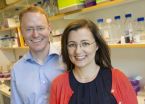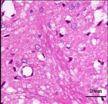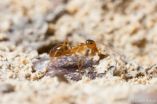(Press-News.org) July 7, 2014, Shenzhen, China— Researchers from BGI, working within the Metagenomics of the Human Intestinal Tract (MetaHIT) project, and in collaboration with other institutions around the world , have established the highest quality integrated gene set for the human gut microbiome to date- a close-to-complete catalogue of the microbes that reside inside us and massively outnumber our own cells. While the roughly 20,000 genes in the human genome have been available for over a decade, the gene catalog of the microbiome, our much larger "other genome", has to date been much more poorly understood and characterized.
The data released from this study should facilitate further research on the interactions between human and microbial genomes, and brings us closer to an understanding of how to maintain the microbial balance that keeps us healthy. The latest study was published online today in the journal Nature Biotechnology.
Each of our guts is colonized by more than 3 pounds of microorganisms that can break down toxins, manufacture vitamins and essential amino acids, and form a barrier against invaders. However, until now there has been a lack of comprehensive and uniformly processed database resources cataloging the human gut microbiota around the world, which has hindered our knowledge of the genetic and functional mechanism of human gut microbes.
In this study, researchers established a catalog of the human gut microbial genes by processing 249 newly sequenced samples and 1,018 published samples from MetaHIT, Human Microbiome Project (HMP) and a large diabetes study from China, as well as 511 sequenced genomes of gut-related bacteria and archaea. This expanded research is at least three times larger than the cohorts used for previous gene catalogs.
Based upon the catalog, researchers investigated the gut microbiota of healthy Chinese and Danish adults, and found the two cohorts greatly differed in nutrient metabolism as well as xenobiotic detoxification, which might be influenced by the differences in diet and environment. In addition, they observed enrichment in possible antibiotic resistance genes both at the population level (penicillin resistance in Danes and multidrug resistance in Chinese) and in the individual-specific genes, which highlighted the need for close monitoring of direct and indirect exposure to antibiotics.
Individual-specific genes contributed overwhelmingly to the increased total gene number in the integrated gene catalog and were overrepresented in genes responsible for the synthesis of cell wall components, DNA-related functions such as transposases, endonucleases and DNA methylases and encoding phage-related proteins. Such individual-specific genes likely reflect adaptation and might reflect the distinct combination of genetic, nutritional and medical factors in a host.
This nonredundant reference catalog of over 9.8 million genes is freely accessible through the website and the data have also been deposited in BGI's GigaScience Database, GigaDB and the SRA. It provides a much expanded and invaluable resource for global researchers to more deeply explore the geographical, genetic, temporal and physiological characteristics of gut microbes.
Junhua Li, Research Scientist from BGI, said, "Catalogs of reference genes in the human gut microbiome should facilitate quantitative characterization of multi-omic data from the gut microbiome to understand its variation across populations in human health and disease."
INFORMATION: END
BGI presents a high-quality gene catalog of human gut microbiome
2014-07-07
ELSE PRESS RELEASES FROM THIS DATE:
Gene therapy and the regeneration of retinal ganglion cell axons
2014-07-07
Because the adult mammalian central nervous system has only limited intrinsic capacity to regenerate connections after injury, due to factors both intrinsic and extrinsic to the mature neuron, therapies are required to support the survival of injured neurons and to promote the long-distance regrowth of axons back to their original target structures. The retina and optic nerve are part of the CNS and this system is much used in experiments designed to test new ways of promoting regeneration after injury. Testing of therapies designed to improve RGCs viability also has direct ...
Changing Antarctic winds create new sea level threat
2014-07-07
New research shows projected changes in the winds circling the Antarctic may accelerate global sea level rise significantly more than previously estimated.
Changes to Antarctic winds have already been linked to southern Australia's drying climate but now it appears they may also have a profound impact on warming ocean temperatures under the ice shelves along the coastline of West and East Antarctic.
"When we included projected Antarctic wind shifts in a detailed global ocean model, we found water up to 4°C warmer than current temperatures rose up to meet the base of ...
Visualization of peripheral nerve regeneration
2014-07-07
Researchers at the Institute of Polymer Science and Engineering in Taipei, Taiwan, led by Dr. Hsu have been involved in peripheral nerve regeneration research for more than ten years. Dr. Hsu and her team have focused on development of polymeric nerve conduits to facilitate peripheral nerve regeneration. To better translate the research from animal experiments to human therapies, they have recently paid more attention on clinically available methods to visualize the peripheral nerve regeneration process.
This mini-review in Neural Regeneration Research (Vol. 9, No. 10, ...
China's hidden water footprint
2014-07-07
China's richest provinces have an outsized environmental impact on the country's water-scarce regions, according to new research from the International Institute for Applied Systems Analysis (IIASA) and the University of Maryland.
Many developed regions in China are not only drawing from their own water resources but also contributing to water depletion in other water-scarce regions of the country through imports of food and other water-intensive goods, according to the new study published in the journal Environmental Science & Technology. This has environmental impacts ...
DNA origami nano-tool provides important clue to cancer
2014-07-07
Researchers at Karolinska Institutet in Sweden have headed a study that provides new knowledge about the EphA2 receptor, which is significant in several forms of cancer. This is important knowledge in itself – but just as important is how this study, which is published in the highly respected journal Nature Methods, was conducted. The researchers used the method of DNA origami, in which a DNA molecule is shaped into a nanostructure, and used these structures to test theories about cell signalling.
It was previously known that the EphA2 receptor played a part in several ...
Dental pulp stem cells promote the survival and regeneration of retinal cells after injury
2014-07-07
Researchers at the University of Birmingham, UK, led by Dr. Ben Scheven, Dr. Wendy Leadbeater and Ben Mead have discovered that stem cells isolated from the teeth, termed dental pulp stem cells (DPSC), can protect retinal ganglion cells (RGCs) from death following injury and promote regeneration of their axons along the optic nerve.
RGC loss is the leading cause of blindness and can arise through traumatic injury or degenerative diseases such as glaucoma. Neurotrophic factors (NTFs), which travel along the axon of a neuron to a cell body act as survival signals however, ...
Houshiheisan maintains stabilization of the internal environment of neurovascular units
2014-07-07
Cerebral ischemia not only injuries neurons, but also involves the glial cells that provide a supportive scaffold to which the neurons are attached and the microvessels that provide energy for nervous tissue. Therefore, protection of a single neuron is not sufficient to recover nervous function, and more attention should be paid to maintenance of the function of entire neurovascular units. Houshiheisan compound is one of effective traditional Chinese compound prescriptions for stroke. The prescription is composed of wind-dispelling (chrysanthemun flower, divaricate saposhnikovia ...
Ultra-cold atom transport made simple
2014-07-07
Techniques for controlling ultra-cold atoms travelling in ring traps currently represent an important research area in physics. A new study gives a proof of principle, confirmed by numerical simulations, of the applicability to ultra-cold atoms of a very efficient and robust transport technique called spatial adiabatic passage (SAP). Yu Loiko from the University of Barcelona, Spain, and colleagues have, for the first time, applied SAP to inject, extract, and filter the velocity of neutral atoms from and into a ring trap. Such traps are key to improving our understanding ...
Science and cookies: Researchers tap into citizen science to shed light on ant diversity
2014-07-07
Scientists from North Carolina State University and the University of Florida have combined cookies, citizen science and robust research methods to track the diversity of ant species across the United States, and are now collaborating with international partners to get a global perspective on how ants are moving and surviving in the modern world.
"We think our School of Ants project serves as a good model for how citizen science can be used to collect more data, more quickly, from more places than a research team could do otherwise," says Dr. Andrea Lucky, a researcher ...
Concern at lack of teenage patients in cancer trials
2014-07-07
Age limits on clinical trials need to be more flexible to allow more teenage cancer patients the chance to access new treatments, according to a report from the National Cancer Research Institute (NCRI), published in the Lancet Oncology.
The study, funded by the National Institute for Health Research and Teenage Cancer Trust, found that trials designed with broader age limits resulted in more teenagers and young adults going on clinical trials.
The study showed this recommendation led to a 13 per cent rise in 15-19 year old cancer patients taking part in clinical trials ...


